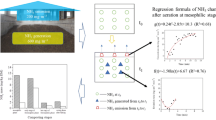Abstract
The treatment of poorly water soluble waste gas compounds,such as ethene, is associated with low substrateconcentration levels in the liquid phase. This lowconcentration level might hamper the optimal development ofa microbial population. In this respect, the possible benefit ofintroducing nitrifying activity in the heterotrophic removal ofethene at moderate concentrations (< 1000 ppm) from awaste gas was investigated. Nitrifying activity is known to beassociated with (i) the production of soluble microbialproducts, which can act as (co-)substrates for heterotrophicmicro-organisms and (ii) the co-oxidation of ethene. Theused reactor configuration was a packed granular activatedcarbon biobed inoculated with the heterotrophic strain Mycobacterium E3. The nitrifying activity was introduced byregular submersion in a nitrifying medium prepared from (i)compost or (ii) activated sludge. In both cases a clearenhancement of the volumetric removal rate of ethene couldbe observed. When combined with a NH3 dosage on adaily basis, a gradual increase of the volumetric removal rateof ethene could be observed. For a volumetric loading rateof 3 kg ethene-COD·m-3·d-1, the volumetric removal rate could thus be increased with a factor1.8, i.e. from 0.72 to a level of 1.26 kgethene-COD·m-3·d- 1.
Similar content being viewed by others
References
Atlas RM & Bartha R (1992) Microbial Ecology. Fundamentals and Applications. The Benjamin/Cummings Publishing Company Redwood City, California
Boethling RS & Alexander M (1979) Effect of concentration of organic chemicals on their biodegradation by natural microbial communities. Appl. Environ. Microbiol. 37: 1211–1216
Bremmer JM & Keeney RD (1965) Steam distillation methods for the determination of ammonium, nitrate and nitrite. Anal. Chim. Acta 32: 485–495
De Bont JAM(1976) Oxydation of ethylene by soil bacteria. Antonie van Leeuwenhoek 42: 59–71
De heyder B, Overmeire A, Van Langenhove H & Verstraete W (1994) Ethene removal from a synthetic waste gas using a dry biobed. Biotechnol. Bioeng. 44: 642–648
Diks RMM & Ottengraf SPP (1991) Verification studies of a simplified model for the removal of dichloromethane from waste gases using a biological trickling filter. Bioproc. Eng. 6: 93–99
Fumurai H & Rittmann BE (1992) Advanced modelling of mixed microbial populations of heterotrophs and nitrifiers considering the formation and exchange of soluble microbial products. Wat. Sci. Tech. 26: 493–502
Fumurai H & Rittmann BE (1994) Interpretation of bacterial activities in nitrification filtersby a biofilm model considering the kinetics of soluble microbialproducts. Wat. Sci. Tech. 30: 147–156
Gellens V & VerstraeteW(1995) Inter-region recycling of anaerobic digested biowaste. In: Bioremediation: The TokyoWorkshop '94 (pp 485-490). OECD, Paris
Habets-Cr¨utzen AQH, Brink LES, Van Ginkel CG, De Bont JAM & Tramper J (1984) Production of epoxides from gaseous alkenes by resting cell suspensions and immobilized cells of alkene-utilizing bacteria. Appl. Microbiol. Biotechnol. 20: 245–250
Hartmans S & Tramper J (1991) Dichloromethane removal from waste gases with a trickle-bed bioreactor. Bioproc. Eng. 6: 83–92
Kanagawa T & Mikami E (1989) Removal of methanethiol, dimethyl sulfide, dimethyl disulfide and hydrogen sulfide from contaminated air by Thiobacillus thioparusTK-m. Appl. Environ. Microbiol. 55: 555–558
KeenerWK & Arp DJ (1993) Kinetic studies of ammonia monooxygenase inhibition in Nitrosomonas europeaeby hydrocarbons and halogenated hydrocarbons in an optimized whole cell assay. Appl. Environ. Microbiol. 59: 2501–2510
Kirchner K, Gossen CA & Rahm H-J (1991) Purification of exhaust air containing organic pollutants in a trickle bed reactor. Appl. Microbiol. Biotechnol. 35: 396–400
l'Air Liquide (1976) deEncyclopedie des gaz. Elsevier Science Publishing Company Amsterdam
Rittmann BE, Regan JM & Stahl DA (1994) Nitrification as a source of soluble organic substrate in biological treatment. Wat. Sci. Tech. 30: 1–8
Schmidt SK & Alexander M (1985) Effects of dissolved organic carbon and second substrates on the biodegradation of organic compounds at low concentrations. Appl. Environm. Microbiol. 49: 822–827
Shareefdeen Z, Baltzis BC, Oh Y-S & Bartha R (1993) Biofiltration of methanol vapor. Biotechnol. Bioeng. 41: 512–524
Sly LI, Bryant LJ, Cox JM & Anderson JM (1993) Development of a biofilter for the removal of methane from coal mine ventilation atmospheres. Appl. Microbiol. Biotechnol. 39: 400–404
Van Ginkel CG, Welten HGJ, De Bont JAM & Boerrigter HAM (1986) Removal of ethene to very low concentrations by immobilised MycobacteriumE3. J. Chem. Tech. Biotechnol. 46: 593–598
Van Ginkel CG, Welten HGJ & De Bont JAM (1987) Growth and stability of ethene-utilizing bacteria on compost at very low substrate concentrations. FEMS Microbiol. Ecol. 45: 65–69
Vansever S, Van der Zanden J, Weytjens D, Migneau C & Verstraete W (1995) Improvement of activated sludge performance by the addition of Nutrifloc S50. In: Proceedings of the 9th Forum on Applied Biotechnology, Part II (pp 2237-2244). Gent, 27-29 September
Verstraete W & Van Vaerenbergh E (1986) Aerobic activated sludge. In: Sch¨onborg W (Ed) Biotechnology, Volume 8, Microbial Degradations (pp 43-112). VCH, Weinheim
Weckhuysen B, Vriens L & Verachtert H (1993) The effect of nutrient supplementation on the biofiltration removal of butanol in contaminated air. Appl. Microbiol. Biotechnol. 39: 395–399
Zilli M, Lodi A, Del Borghi M & Ferraiolo G (1993) Phenol removal from waste gases with a biological filter by Pseudomonas putida. Biotechnol. Bioeng. 41: 693–699
Author information
Authors and Affiliations
Rights and permissions
About this article
Cite this article
De heyder, B., Van Elst, T., Van Langenhove, H. et al. Enhancement of ethene removal from waste gas by stimulating nitrification. Biodegradation 8, 21–30 (1997). https://doi.org/10.1023/A:1008204803231
Issue Date:
DOI: https://doi.org/10.1023/A:1008204803231




